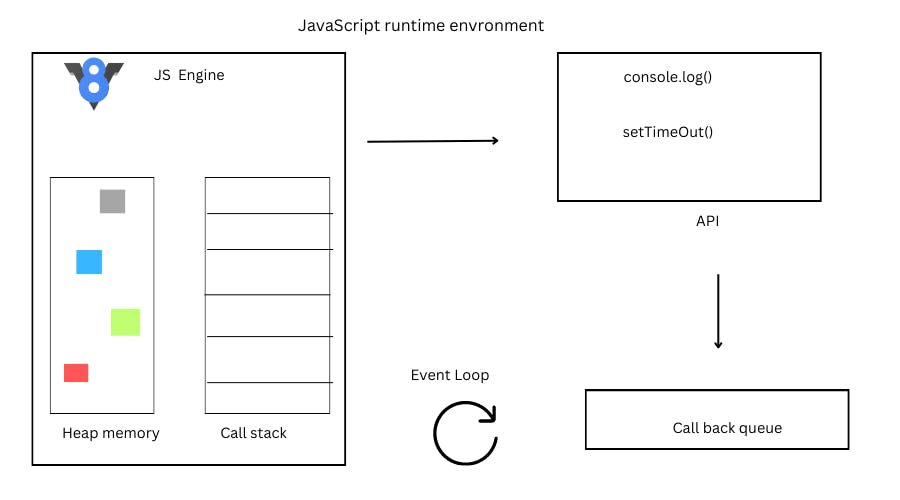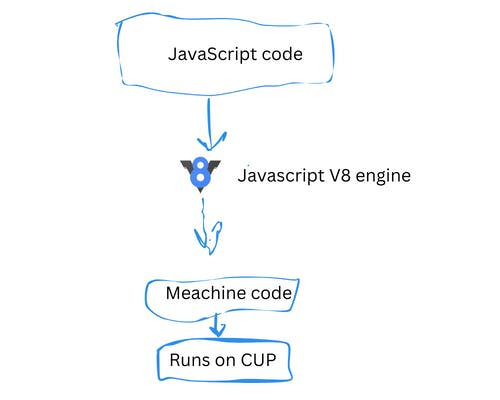Introduction
Node.js has gained immense popularity in the world of web development as a powerful server-side JasaScript runtime.
In this blog post, we will take a beginner-friendly journey into the world of Node.js, exploring its fundamental concepts and its unique features.
What is Node.js
Node.js is a JavaScript runtime environment(JRE) built on Chrome's V8 JavaScript engine. It allows developers to run JavaScript code outside of the browser, on the server side. Traditionally, JavaScript is used within a browser to create interactive web pages. However, with the power of Node.js, javascript can now be used on the server side to access file systems and networks.
What is a JavaScript runtime environment(JRE)?
A JavaScript runtime environment(JRE) is an environment where our JavaScritp code is executed. A JRE comprises many components like an Event loop, Call stack, JavaScript engine, and Callback queue.

JavaScript code just needs a JRE to execute, and with that, we can run JavaScript on any device. For a web app, Browser provides the JRE and for a server app, Node.js provides the JRE.
What is the V8 JavaScript engine?
The V8 engine converts our JavaScript code into machine code so that the computer( CPU) can execute it. It is developed by Google and Chrome browser uses it.

Other JavaScript engines are used by other companies: Firefox use SpiderMonkey, Apple uses JavaScriptCore in Safari and Microsoft uses Chakra in Edge browser.
Key features of Node.js
Node.js offers several key features that make it a powerful and popular choice for server-side development. Let's explore these features:
Asynchronous and Non-blocking I/O:
Asynchronous:
In Node.js, when we say something is asynchronous, it means we can do multiple things at the same time without having to wait for each one to finish before starting the next.
When a function is called asynchronously, it doesn't block the execution of the program. Instead, it allows other operations to continue while waiting for the asynchronous operation to complete. This is achieved through the use of callback, promises, or async/await syntax.
Non-blocking I/O(Input/Output):
I/O operations, such as reading from or writing to a file, or making network requests, are typically slower. In many traditional programming environments(Java, c++, Python), I/O operations are often blocked, meaning that program execution pauses until the I/O operation is finished. However, in Node.js, I/O operations are non-blocking, which means that the program can continue to execute other tasks while waiting for the completion of the I/O operations.
By combining asynchronous and non-blocking I/O, Node.js can handle a large number of concurrent operations efficiently.
Single-Threaded and Event-Driven Architecture
Single-Threaded:
Node.js operates within a single thread of execution. Unlike traditional web servers that create a new thread for each incoming request, Node.js uses a single thread to handle multiple concurrent requests. This single-threaded nature avoids the overhead associated with managing multiple threads. However, it's important to note that Node.js can leverage multiple threads indirectly through techniques like worker threads.
Event-Driven Architecture:
Node.js follows event-driven architecture. In this architecture, the flow of the programme is determined by events that occur rather than a sequence of linear instructions. An event can be any action or occurrence, such as a network request, a file being read, or a timer expiration.
By combining a single-threaded execution model with an event-driven architecture, Node.js achieves high scalability and performance. While a single thread can handle multiple requests, the event-driven nature allows the program to efficiently handle I/O operations.
JavaScript Everywhere:
One of the advantages of Node.js is the ability to use JavaScript for both client-side and server-side development. With Node.js, developers can write server-side logic in JavaScript, resulting in code reusability, improved productivity, and easier knowledge transfer between front-end and back-end teams.
Extensive Ecosystem with npm:
The Node Package Manager (npm) is a tool that comes with Node.js. It is a library that allows developers to access a large number of ready-made code modules provided by other developers. The NPM makes it simple for developers to install, manage, and share these code packages.
Use Cases of Node.js
Node.js has gained significant popularity across various industries. Let's see some of the common scenarios where Node.js excels:
Web Application Development
APIs
Microservices
Real-time Applications
Command Line Tools and Utilities
Internet of Things(IoT)
Conclusion
Node.js has revolutionized server-side JavaScript development, providing a powerful and efficient runtime environment for building scalable and high-performance applications.
With its non-blocking I/O and asynchronous model, Node.js enables developers to handle concurrent requests efficiently.
Its single-threaded, event-driven architecture allows for optimal resource utilization.
Node.js's ability to use JavaScript on both the front and back end allows for easier code sharing and reduces the need for context switching between different programming languages.
Overall, Node.js offers an exciting world of possibilities for creating modern, efficient and scalable server-side applications.